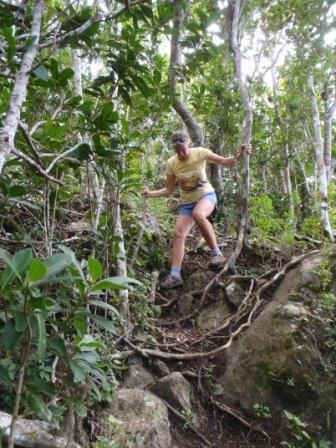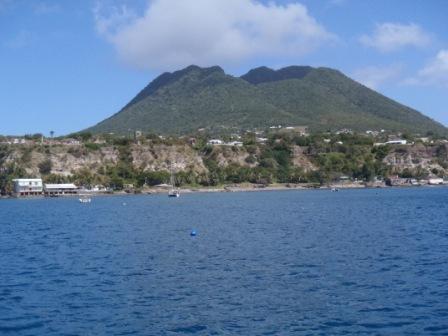Statia2

VulcanSpirit
Richard & Alison Brunstrom
Mon 7 Mar 2011 11:51
|
Today we managed to get up Statia's dormant
volcano, The Quill. The day started badly as we set off early to beat the
heat, only to discover that the brand new Dutch Customs & Immigration office
(in reality two redundant steel containers with a nice posh sign and aircon)
didn't open until 0900hrs and closed again at 1100hrs so if we wanted to get off
the island legally we had to wait for them to arrive. Nine o'clock came and went
with no officials. Turned out they had to service the airport as well and
couldn't be in two places at once. A queue of frustrated yachties built up. Then
it turned out that we hadn't paid our port duties (no sign to say that we needed
to) so we lost our place in the queue. No-one could explain what the fees were
for - all Customs & immigration new to the island and were simply "following
orders". Possibly worse than Portugal - and quite ridiculous when set against
the French system applied at neighbouring St Barts.
The Quill, first photo, is a textbook example of an
ash cone volcano. It last exploded at least 1500 years ago but is classed as
dormant rather than extinct as hot water is found in wells drilled around it.
The crater (600m) is clearly seen, filled with original untouched vegetation -
most of the island was cleared for sugar. The volcano's slopes were cleared too,
leading to quite amazing erosion of topsoil - Amerindian archaeological sites on
the plain below have been covered with a staggering 2 metres of soil since the
Europeans arrived in the 1650s. The path up is well made by National Park
staff, and signposted rendering a guide unnecessary - a first for the Caribbean.
The dry forest on the flanks is extremely quiet - almost the only sound and
movement comes from comical sight of startled land hermit crabs tucking into
their shells and then rolling down the steep hillside, sometimes for a
considerable distance, as a result. Their whole day must be like living
through a game of snakes and ladders.
At the crater rim we stopped for a snack. A large
very well groomed rooster immediately appeared and demanded some of our
lunch, taking it neatly from our hands. It was spicy pasta whirls which slip
down exactly like a worm (though he will have no idea what one
is!).
The top affords a great view of the island, oil
tanks and all, and a distant view of Saba. The large building just visible
to the left of Alison's head is a new American Medical School. Every island
seems to have one (it was 25% of the GDP on St Kitts!!) but with a population of
only 3400 it seems farcical - but another has just opened on Saba where the
medical students comprise one third of the total population of less than
1500! I can't believe that the standards are high enough.
The last part of the trail is through elfin forest
- mini-trees in cloud for much of the time; Alison is seen negotiating the
steep slopes of cinder blocks through this pretty
forest.
And lastly, a big lizard. The island has a snake
found only here and on Saba, the red bellied racer. It's quite common. We didn't
see it. There is a tiny frog. We didn't see that either. And the Antilles Lesser
Iguana, Iguana delicatissima . It's rare here (only 425 on
the island, but doing quite well) and critically endangered throughout its range
(hunted to extinction on many islands). We didn't see one. There is an
endemic plant, the Statia Morning Glory, which flowers at this time of year. We
couldn't find it. But we did see this lovely big lizard (more than 0.5m
long) basking in the sun behind the National Park toilet block, right at the end
of the walk. He's a Red Faced Ground Lizard, found only on Statia, St Kitts
&Nevis.So much for the wildlife - but it was a nice
walk.
|




